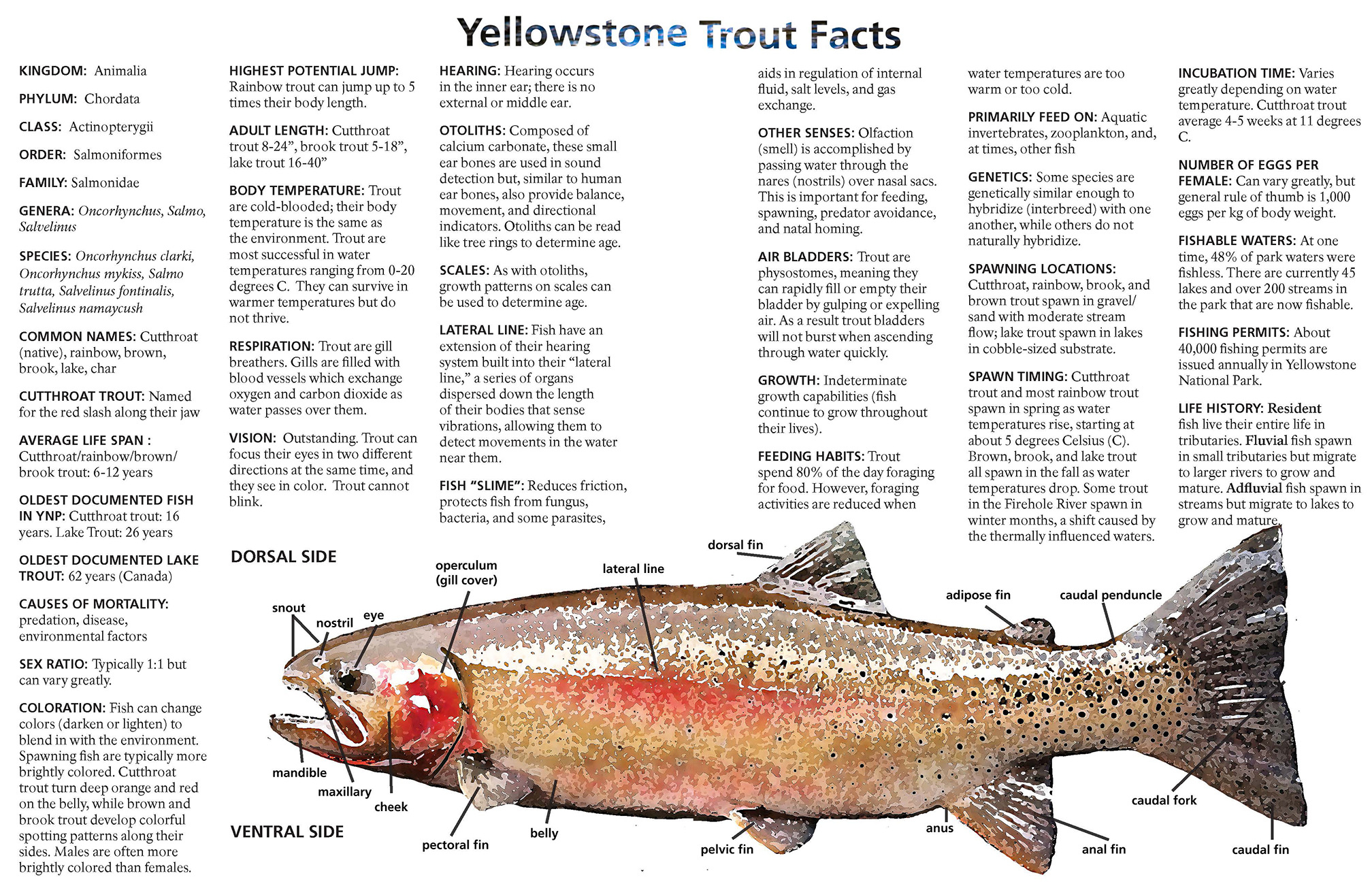
KINGDOM: Animalia PHYLUM: Chordata CLASS: Actinopterygii ORDER: Salmoniformes FAMILY: Salmonidae GENERA: Oncorhynchus, Salmo, Salvelinus SPECIES: Oncorhynchus clarki, Oncorhynchus mykiss, Salmo trutta, Salvelinus fontinalis, Salvelinus namaycush COMMON NAMES: Cutthroat (native), rainbow, brown, brook, lake, char CUTTHROAT TROUT: Named for the red slash along their jaw AVERAGE LIFE SPAN : Cutthroat/rainbow/brown/ brook trout: 6-12 years OLDEST DOCUMENTED FISH IN YNP: Cutthroat trout: 16 years. Lake Trout: 26 years OLDEST DOCUMENTED LAKE TROUT: 62 years (Canada) CAUSES OF MORTALITY: predation, disease, environmental factors SEX RATIO: Typically 1:1 but can vary greatly. COLORATION: Fish can change colors (darken or lighten) to blend in with the environment. Spawning fish are typically more brightly colored. Cutthroat trout turn deep orange and red on the belly, while brown and brook trout develop colorful spotting patterns along their sides. Males are often more brightly colored than females. HIGHEST POTENTIAL JUMP: Rainbow trout can jump up to 5 times their body length. ADULT LENGTH: Cutthroat trout 8-24”, brook trout 5-18”, lake trout 16-40” BODY TEMPERATURE: Trout are cold-blooded; their body temperature is the same as the environment. Trout are most successful in water temperatures ranging from 0-20 degrees C. They can survive in warmer temperatures but do not thrive. RESPIRATION: Trout are gill breathers. Gills are filled with blood vessels which exchange oxygen and carbon dioxide as water passes over them. VISION: Outstanding. Trout can focus their eyes in two different directions at the same time, and they see in color. Trout cannot blink. HEARING: Hearing occurs in the inner ear; there is no external or middle ear. OTOLITHS: Composed of calcium carbonate, these small ear bones are used in sound detection but, similar to human ear bones, also provide balance, movement, and directional indicators. Otoliths can be read like tree rings to determine age. SCALES: As with otoliths, growth patterns on scales can be used to determine age. LATERAL LINE: Fish have an extension of their hearing system built into their “lateral line,” a series of organs dispersed down the length of their bodies that sense vibrations, allowing them to detect movements in the water near them. FISH “SLIME”: Reduces friction, protects fish from fungus, bacteria, and some parasites, aids in regulation of internal fluid, salt levels, and gas exchange. OTHER SENSES: Olfaction (smell) is accomplished by passing water through the nares (nostrils) over nasal sacs. This is important for feeding, spawning, predator avoidance, and natal homing. AIR BLADDERS: Trout are physostomes, meaning they can rapidly fill or empty their bladder by gulping or expelling air. As a result trout bladders will not burst when ascending through water quickly. GROWTH: Indeterminate growth capabilities (fish continue to grow throughout their lives). FEEDING HABITS: Trout spend 80% of the day foraging for food. However, foraging activities are reduced when water temperatures are too warm or too cold. PRIMARILY FEED ON: Aquatic invertebrates, zooplankton, and, at times, other fish GENETICS: Some species are genetically similar enough to hybridize (interbreed) with one another, while others do not naturally hybridize. SPAWNING LOCATIONS: Cutthroat, rainbow, brook, and brown trout spawn in gravel/sand with moderate stream flow; lake trout spawn in lakes in cobble-sized substrate. SPAWN TIMING: Cutthroat trout and most rainbow trout spawn in spring as water temperatures rise, starting at about 5 degrees Celsius (C). Brown, brook, and lake trout all spawn in the fall as water temperatures drop. Some trout in the Firehole River spawn in winter months, a shift caused by the thermally influenced waters. INCUBATION TIME: Varies greatly depending on water temperature. Cutthroat trout average 4-5 weeks at 11 degrees C. NUMBER OF EGGS PER FEMALE: Can vary greatly, but general rule of thumb is 1,000 eggs per kg of body weight. FISHABLE WATERS: At one time, 48% of park waters were fishless. There are currently 45 lakes and over 200 streams in the park that are now fishable. FISHING PERMITS: About 40,000 fishing permits are issued annually in Yellowstone National Park. LIFE HISTORY: Resident fish live their entire life in tributaries. Fluvial fish spawn in small tributaries but migrate to larger rivers to grow and mature. Adfluvial fish spawn in streams but migrate to lakes to grow and mature. |
Last updated: February 21, 2017
